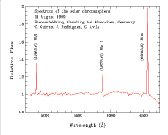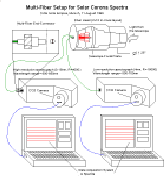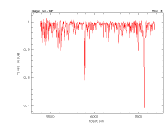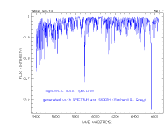Figure 1 The three lines are from right to left: H-alpha (6562.8), Fe-X
(6374) and He-I (5875.6).
 |
Figure 2. Spectrum of the solar
corona showing H-alpha, He-I and H-beta. Equipment: Telescope: Schmidt
Cassegrain F/6.3, diam: 250 mm FIASCO Spectrograph: Fibre: 135 um core
diameter F=300 mm collimator, F = 100 mm camera Grating: 600 gr/mm blazed
@500 nm, CCD Hale-512II, Resolution: ~ 3.5 nm. Exposure time: 2 s |
 |
Layout of the telescope-spectrographs
configuration for the Total Solar Eclipse 11th August 1999. 13 fibres were
used in total. Figure 1 was taken with the high resolution spectrograph
(Resolution 0.5nm, Range 530-670nm), while figure 2 was taken with
a low resolution spectrograph (Resolution 3.5 nm, Range 480-680nm). |
 |
Spectrum of the Sun the 11th
August 1999, minutes after the total eclipse. It was taken with the high
resolution spectrograph in the wavelength range 530-670 nm |
 |
For comparation with the real
sun spectra above, this is a synthetic spectra generated with programs
SPECTRUM (Peter O.Gray) and SMOOTH for Linux. |